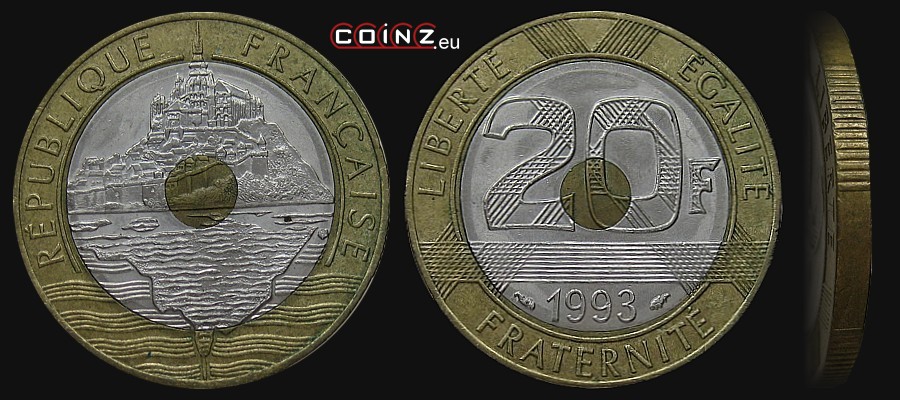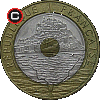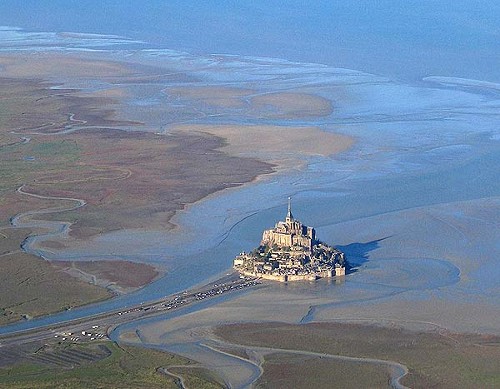20 francs FRANCE (1992-2001)



| diameter: | weight: | thickness: | alloy: |
| 27.0 mm | 9.0 g | 2.2 mm | Cu92Al6Ni2 / Ni / Cu92Al6Ni2 |
obverse:
above coin centre Mont Saint-Michel; below coin centre reflection of the mount in waves; along the top edge: RÉPUBLIQUE FRANÇAISE (French Republic)
reverse:
in coin centre face value: 20 F (FRANCS); below year of issue; along the top edge: LIBERTÉ ÉGALITÉ, along the bottom one: FRATERNITÉ (liberty, equality, fraternity); in the background banches of parallel stripes
edge:
five plain and five reeded sections or four plain and four reeded in part of 1992 issue
issue date:
??? no data
withdrawal date:
18 II 2002
designer:
Atelier de gravure (group of designers of the Paris Mint - rosette in the water at right flank of the mount in the obverse)
mint:
 La Monnaie de Paris (The Paris Mint), Pessac (mint mark before year of issue in the reverse, after year of issue privy mark of mint's director Emile Rousseau - dolphin - in years 1992-1994, Pierre Rodier - bee - in years 1994-2000 or Gérard Buquoy - horseshoe - in 2001)
La Monnaie de Paris (The Paris Mint), Pessac (mint mark before year of issue in the reverse, after year of issue privy mark of mint's director Emile Rousseau - dolphin - in years 1992-1994, Pierre Rodier - bee - in years 1994-2000 or Gérard Buquoy - horseshoe - in 2001)
mintage:
| 1992 | 59 966 063 | dolphin | + 2 698 in annual boxed sets |
| 1993 | 54 970 011 | dolphin | + 3 095 in annual boxed sets |
| 1994 | 5 000 000 | dolphin | |
| 1994 | 9 970 061 | bee | + 3 707 in annual boxed sets |
| 1995 | 9 976 011 | bee | + 4 000 in annual boxed sets |
| 1996 | 12 013 | bee | + 5 000 in annual boxed sets |
| 1997 | - | bee | + 15 000 in annual boxed sets |
| 1998 | - | bee | + 25 000 in annual boxed sets |
| 1999 | - | bee | + 25 000 in annual boxed sets |
| 2000 | - | bee | + 100 000 in annual boxed sets |
| 2001 | - | horseshoe | + 125 000 in annual boxed sets |
varieties:
1992 - four ot five reeded sections on the edge - among these two varieties there exist two further varieties of a set-up of parallel stripes in the reverse. It is easiest to recognise by the lines crossing above the face value in the outer ring. plain surface between the stripes has a shape of a triangle \/ or a trapezoid \_/
In years 1992 and 1993 there exist coins with reverses not rotated by 180° in respect to obverses (medal alignment in American terminology) - 2 698 and 3 095 pieces were produced in respective years and placed in annual boxed sets
1994 - coins with a privy mark of mint's director Emile Rousseau dolphin or with the privy mark of Pierre Rodier bee
In years 1992 and 1993 there exist coins with reverses not rotated by 180° in respect to obverses (medal alignment in American terminology) - 2 698 and 3 095 pieces were produced in respective years and placed in annual boxed sets
1994 - coins with a privy mark of mint's director Emile Rousseau dolphin or with the privy mark of Pierre Rodier bee
mint marks:
interesting facts:
The Mont Saint-Michel is an island in the English Channel regularly dipped by tidal waves. At low tide one can get dry feet to the fortified Benedictine abbey and the town. The mount is one of the largest tourist attractions of France.


last update: 20 XI 2013
coins catalogue :: katalog monet :: münzkatalog :: catalogue de monnaies :: catálogo de monedas :: catalogo monete :: каталог монет :: κέρματα κατάλογος :: COINZ.eu
© 2010-2025 :: Adam Kubicki :: COINZ.eu :: All rights reserved.


